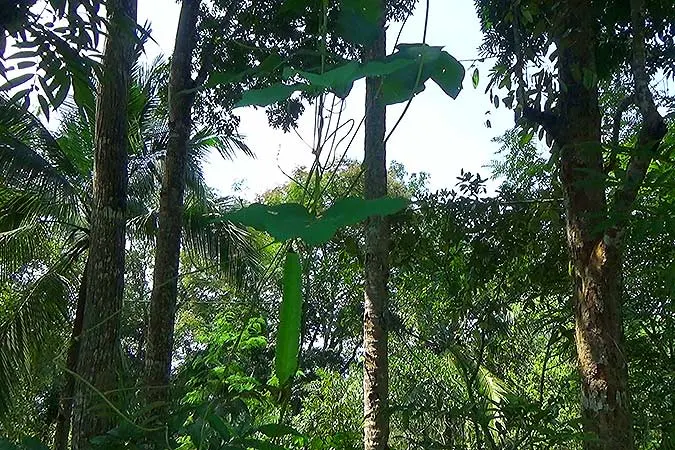Kecipir or winged bean (Psophocarpus tetragonolobus) is a plant species in Fabaceae, growing climbing or twisting or creeping to form chronic bushes or filling the soil surface if without support, shoots and young pods are used as vegetables and medicine.
P. tetragonolobus has cylindrical stems, segmented, rarely forming wood, up to 4 m long and green or brown. Many roots with long and flat side roots spread near the surface of the soil, some of which thicken to form tubers.
Compound leaves with three minor leaves, sitting alternately, stalks of 3-12 cm long and 1.5-5.5 cm greedy. The minor leaves are egg-shaped up to a triangle, 4-15 cm long, 3.5-12 cm wide, angled base, pointed tip, green, a main bone in the middle and minor bones are pinned.
A butterfly-shaped flower in panicles with 2-10 buds growing from armpits of the leaves, panicle stems 5-15 cm long, 1-10 cm greedy and slightly hairy. Double-clad, up to 5 mm, tubular petals with a length of 4-6 mm, non-uniform, 2 mm and green to dark red-purple.
The crown is blue or pale blue or beige or reddish with an almost round or oval-wide flag, 4x3.5 cm, wings and keel are slightly shorter. About 10 stamens in two larvae and ovaries will hitchhike.
Elongated pods, rectangular in shape with uneven winged angles, 6-40 cm long, 2-3.5 cm wide, green when young to turn black and dry when old. Pods have 5-21 seeds, round, 5-10 mm in diameter, yellow or brown or black, sometimes white and spotted.
Winged beans like good soil and adequate sunlight at an altitude up to 1000 m in the tropics. Young fruits and leaves are usually boiled for vegetables. Root tubers can be eaten after boiling, but must be harvested before the fruit gets old. The seeds are eaten as beans after roasting.
Seeds and leaves contain flavonoids, saponins and tannins. Leaf extract is used to treat swollen eyes and earaches. Squeezed leaves to treat ulcers. Kecipir contains up to 36.6% protein, 17.9% fat, phosphorus, calcium, magnesium, carbohydrates, vitamin C and tocopherol.
Kingdom: Plantae
Phylum: Tracheophyta
Subphylum: Angiospermae
Class: Magnoliopsida
Order: Fabales
Family: Fabaceae
Subfamily: Faboideae
Tribe: Phaseoleae
Subtribe: Phaseolinae
Genus: Psophocarpus
Species: Psophocarpus tetragonolobus
P. tetragonolobus has cylindrical stems, segmented, rarely forming wood, up to 4 m long and green or brown. Many roots with long and flat side roots spread near the surface of the soil, some of which thicken to form tubers.
Compound leaves with three minor leaves, sitting alternately, stalks of 3-12 cm long and 1.5-5.5 cm greedy. The minor leaves are egg-shaped up to a triangle, 4-15 cm long, 3.5-12 cm wide, angled base, pointed tip, green, a main bone in the middle and minor bones are pinned.
A butterfly-shaped flower in panicles with 2-10 buds growing from armpits of the leaves, panicle stems 5-15 cm long, 1-10 cm greedy and slightly hairy. Double-clad, up to 5 mm, tubular petals with a length of 4-6 mm, non-uniform, 2 mm and green to dark red-purple.
The crown is blue or pale blue or beige or reddish with an almost round or oval-wide flag, 4x3.5 cm, wings and keel are slightly shorter. About 10 stamens in two larvae and ovaries will hitchhike.
Elongated pods, rectangular in shape with uneven winged angles, 6-40 cm long, 2-3.5 cm wide, green when young to turn black and dry when old. Pods have 5-21 seeds, round, 5-10 mm in diameter, yellow or brown or black, sometimes white and spotted.
Winged beans like good soil and adequate sunlight at an altitude up to 1000 m in the tropics. Young fruits and leaves are usually boiled for vegetables. Root tubers can be eaten after boiling, but must be harvested before the fruit gets old. The seeds are eaten as beans after roasting.
Seeds and leaves contain flavonoids, saponins and tannins. Leaf extract is used to treat swollen eyes and earaches. Squeezed leaves to treat ulcers. Kecipir contains up to 36.6% protein, 17.9% fat, phosphorus, calcium, magnesium, carbohydrates, vitamin C and tocopherol.
Kingdom: Plantae
Phylum: Tracheophyta
Subphylum: Angiospermae
Class: Magnoliopsida
Order: Fabales
Family: Fabaceae
Subfamily: Faboideae
Tribe: Phaseoleae
Subtribe: Phaseolinae
Genus: Psophocarpus
Species: Psophocarpus tetragonolobus
